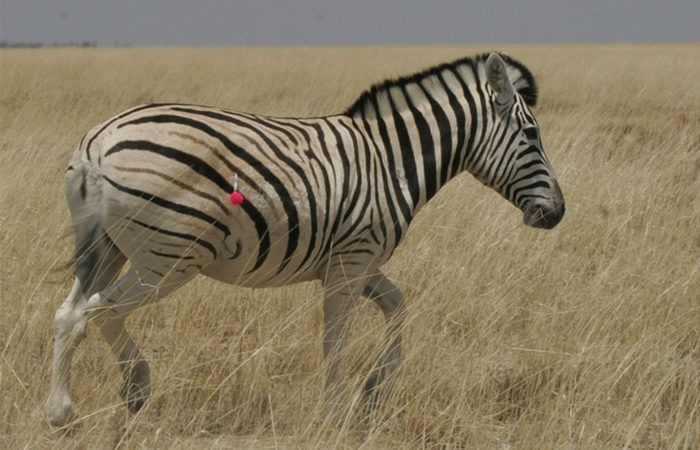
How the Zebra Changed its Stripes: Evolution of Stripe Variation in the Plains Zebra
Have you ever wondered why zebra have stripes? There are many hypotheses, including crypsis, predator confusion, thermoregulation, and avoidance of tsetse fly bites (through which a trypanosome causing sleeping sickness is transmitted), but no one really knows the answer. Variation is an important key to understanding how and why zebra stripes evolved. If all zebra looked alike we would have no easy way of understanding how stripes evolved – what genes code for stripes or what ecological forces have selected for stripes. Fortunately, plains zebra show a lot of variation in stripe pattern that we can make use of, including populations with zebra that are fully striped from head to toe and others in which zebra have few or no stripes on their legs. The extinct quagga subspecies only had stripes to the shoulder.

Striped variation in the plains zebra.
Working with collaborators at UCLA and elsewhere, I am taking advantage of this stripe variation to study both the genetic basis (how) and adaptive reasons (why) for zebra stripes. To identify genes responsible for stripe variation, we are sampling in several wild populations, including some with fully striped zebra and others with zebra with less striping. We also will take advantage of something rarely available for studies of this sort – a captive population that has been under human-mediated selection for a trait that is exhibited in the wild. The Quagga Project was started more than 20 years ago with 18 wild founder zebra and has been breeding zebra for four generations in an effort to bring back the minimally striped phenotype of the quagga subspecies. They have been very successful at breeding zebra with very little striping. Sampling from both wild and domestic populations allows us to leverage the different advantages each has to offer.
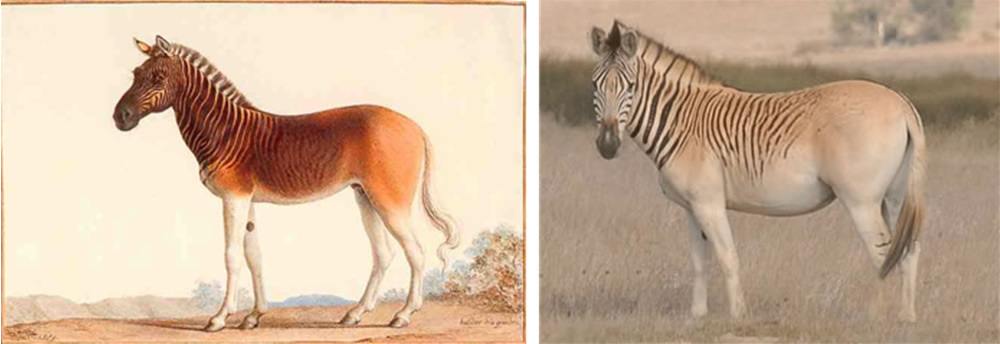
A 1793 illustration of King Louis XVI’s quagga stallion by Nicolas Marechal. Right: Henry – a fourth generation Quagga Project zebra.
To correlate genes with stripe pattern, we need a good photo and plenty of high-quality DNA. The least invasive way to get the DNA we need is to collect a remote biopsy sample. We use a dart gun to shoot a syringe affixed with a biopsy needle. When the needle hits the zebra, it cuts a tiny bit of skin tissue and then falls out. The zebras may startle a little when they are hit, but they typically calm down right away and go back to grazing. We then locate where the dart fell and collect the sample.
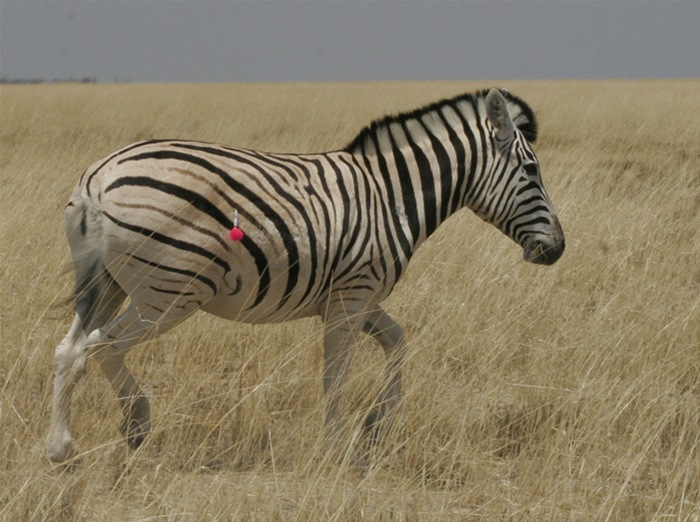
Darted zebra at Etosha National Park, Namibia.
In 2009, CTR Director Tom Smith and I visited Etosha National Park in Namibia and Hluhluwe-Imfolozi National Park in South Africa to collect samples. Sampling was easy in these well-visited parks where animals are used to cars and people. We also visited the Quagga Project in the Cape region of South Africa, but these zebra were skittish as they are less used to human traffic. The Quagga Project will be collecting blood samples for us during their upcoming capture effort as they plan for a 5th generation, and I will revisit the project this fall with blinds and salt licks to try to get close enough to dart some myself. Using the samples we previously collected in Africa, I have been working in Professor Robert Wayne’s lab at UCLA and Professor Sergey Nuzhdin’s lab at the University of Southern California, using high-throughput genome sequencing technologies to generate tens of thousands of markers across the entire genome that we can use to discover correlations between genetic variation and stripe variation.
To understand the adaptive reasons for stripe pattern variation, we are using spatial modeling to correlate stripe pattern variation with environmental variation. So far, I have quantified striping in 107 zebra from 21 populations using my own photos, those of other researchers, and tourist photos from sites like Flikr (as long as the location is clearly stated). Working with Dr. Henri Thomassen, a Senior Research Fellow at CTR, I modeled the distribution of stripe pattern characteristics. The results so far are preliminary, but the map on the right shows the distribution of leg striping as predicted by 16 environmental variables and geographic distance. Modeling shows that several ecological variables are correlated with stripe variation even after geographic distance is accounted for, which suggests that there may be an adaptive component to stripe variation that merits further exploration.
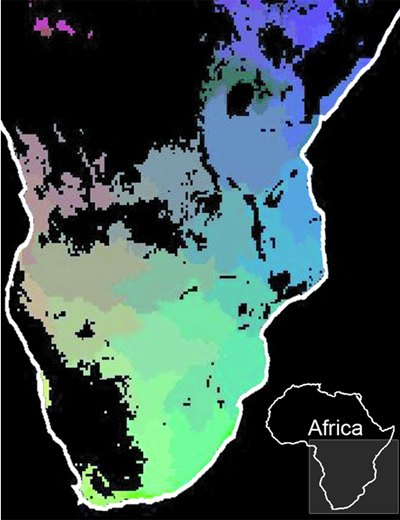
Predicted distribution of leg stripes.
Blue/violet: more striped. Green/yellow: less striped.
As the graph shows, zebra from northern populations are fully striped on the legs, while zebra from southern populations are always less striped, but the extent of leg striping varies widely. The graph also illustrates maximum annual vegetation density (NDVImax), one of the environmental variables most strongly associated with the amount of striping on the legs. But why would vegetation density be important? Perhaps there is an interaction between vegetation density and stripe pattern that influences predation risk, or perhaps tsetse flies are more common in areas with higher vegetation density. Zebra stripes have been shown to deter tsetse fly bites, which predicts more striping where tsetse flies are common.
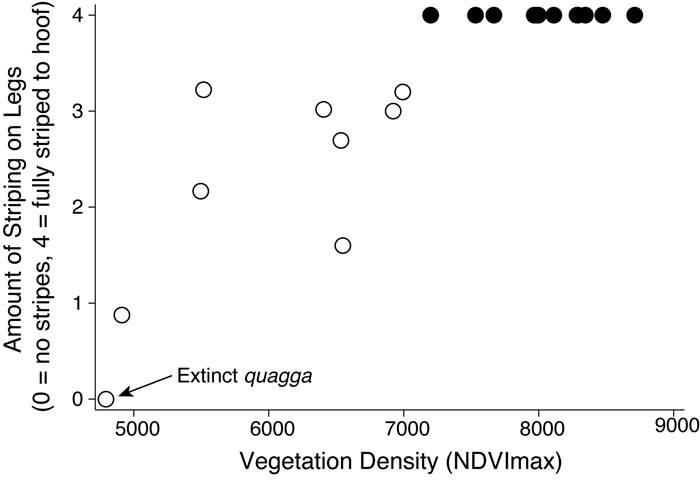
Graph plotting the amount of striping on legs against vegetation density. Black circles represent zebra populations from the northern part of their range. Open circles represent southern populations.
The stripe variation that I have described so far is just the tip of the iceberg. Zebra have a lot of other interesting stripe variants. An exciting but rare zebra pattern we plan to study is SPOTS! Yes, some zebra have spots. They may be light-colored zebra with dark spots instead of stripes, or they may be melanistic zebra with white spots. In Etosha National Park, there are a number of melanistic zebra that are not spotted, but their stripes blend together until their torsos are almost solid black. We are working with local veterinarians and others to collect DNA and photos of these rare individuals. By identifying the genes harboring the mutations that result in these beautiful patterns, we can shed additional light on the biological mechanisms responsible for zebra stripes.
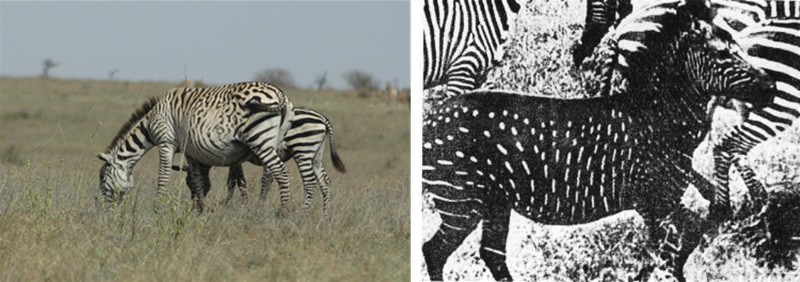
Spotted zebra photographed in Nairobi National Park in Kenya in 2009. Right: Spotted zebra from Botswana photographed in 1967.
Photos contributed by: Brenda Larison, Dan Rubenstein, Quagga Project, and Kenya Wildlife Service
Zulu story about the origin of zebra stripes
(as told to Brenda Larison by a researcher in Kwa-Zulu Natal)
“When the Creator first made the animals, they all had identical dull grey coats. One day the Creator got inspired and created many new coats with beautiful colors and patterns and the word went out that the animals could come claim them, first-come, first-pick. The animals headed off to claim their new coats, but the zebra got distracted and stopped to graze. When a giraffe passed by with its new coat, the zebra said to himself, ’Oh, how beautiful, I must go claim a coat for myself,’ but before long he stopped again to graze. This pattern repeated, with the zebra being newly inspired to go claim his own coat as newly beautiful lion, cheetah, kudu, and other animals passed by, but then, just as quickly, he would be distracted by all the delicious grass and return to grazing. When the zebra finally reached his destination, there was but a single solid black coat left, so he put it on. But he had grown so fat with grazing that the coat shredded as he pulled it over his swollen belly. The zebra decided the shredded black coat was still better than his old grey coat, so he kept it, and that is how the zebra got its stripes.”
